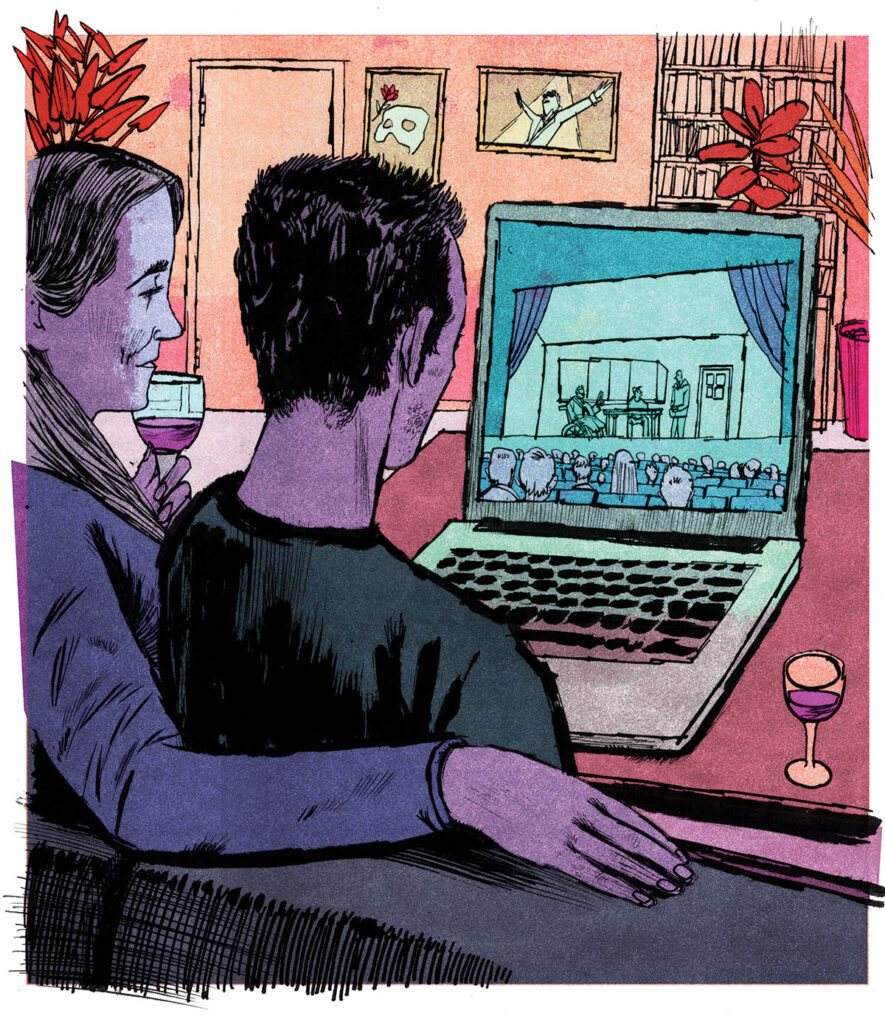
There’s no real substitute for live theater, but during the pandemic lockdown, companies across America hastily threw together online performances to keep their audiences engaged and their actors at least partially employed. “Zoom theater” grew increasingly skillful over the 18 months that theaters were closed, though an essential weirdness remained—that of watching actors in front of individual computers doing their best to interact with other actors in front of their computers. As the lockdown eased, it was possible to bring creative teams together for in-person performances, though the audiences were still remote.
Philadelphia’s Wilma Theater produced an innovative “all-digital season” in 2020–21: while adhering to Covid safety procedures, actors and crew in a remote farmhouse produced what The New York Times called “beautiful film-stage hybrids” that people could watch online. The Wilma claimed viewers in 49 states and 15 countries, and its peers also had surprisingly large online audiences; the Red Bull Theater, a small New York company that usually performs in venues with a few hundred seats, was astonished to learn that its online reading of Ben Jonson’s Volpone attracted 10,000 viewers.
Such numbers swiftly declined when the theaters reopened in September 2021, and in-person attendance has yet to return to prepandemic levels. One solution to the problem of diminished ticket sales is to take advantage of the lessons learned during Covid and to make live theater accessible to more people. Whether it’s livestreamed (you buy a virtual ticket and sit down at your monitor at curtain time to watch the performance as it happens) or a livestream “capture” (a recording that virtual ticketholders can view later), digital presentation is becoming an accepted adjunct to theater companies’ primary commitment to live performance. The static archival recordings that theater historians and fans had to rely on for decades have been replaced by sophisticated, multicamera livestreams that come closer to reproducing the excitement of being there.
Occasional live television broadcasts of theatrical performances have occurred since the Carol Channing vehicle Show Girl aired in 1961, but livestream theater went big and went global in 2009, when London’s National Theatre broadcast a performance of Racine’s Phèdre to nearly 300 movie theaters worldwide. In America, online viewing began in 2016, when the newly launched BroadwayHD livestreamed the Roundabout Theatre Company’s production of the musical She Loves Me to viewers in more than 60 countries. BroadwayHD soon settled into a comfortable niche as a subscription service offering on-demand access to Broadway shows and Broadway-caliber shows—that is, musicals and star vehicles. That worked for commercial producers and the more crowd-pleasing offerings of bigger nonprofit theaters like the Roundabout. But the question for most nonprofit and regional companies, dedicated to showcasing playwrights and more challenging work, was whether livestreaming could help support that mission.
Enter the League of Live Stream Theater (LOLST) in January 2022. LOLST offers virtual tickets for individual performances and focuses on nonmusical plays. It lowers a theater’s upfront risk by providing equipment, remote camera operators, and a platform for viewer access; after it has recouped expenses, it shares any profits with the theater. LOLST debuted with the Second Stage production of Clyde’s, by Pulitzer Prize winner Lynn Nottage, but a surprising number of its livestreams spotlight lesser-known playwrights. “We’re looking to amplify the voices of a new generation of artists,” says cofounder Jim Augustine, “many of whom are embracing new technologies and new ways of storytelling, speaking from local experience, but to large global audiences—about diaspora experiences, immigrant experiences, experiences that are on the edges of things.” A case in point was My Mama and the Full-Scale Invasion—a play about Russia’s invasion of Ukraine told through the story of Ukrainian playwright Sasha Denisova’s family—which streamed from the Wilma for four nights in February 2023. A more recent offering in this vein was I Am Delivered’t, a comedy by Jonathan Norton about gay parishioners at a Black church; three performances were livestreamed from the Actors Theatre of Louisville in March 2024. In both cases, as is true for almost all livestreams, the cost of a virtual ticket was roughly equivalent to that of the least expensive seats in the house. And, as Actors Theatre artistic programming codirector Amelia Acosta-Powell says, “Most people don’t watch alone, so one virtual ticket might be for a family of four to watch the show.”
Acosta-Powell has no problem with that. And the theater managers I’ve spoken to do not seem to think that selling virtual tickets harms in-person attendance. “I had that concern initially,” says Jessica Sherman, marketing director of the Two River Theater in Red Bank, New Jersey. “My whole job right now is to bring people back into this amazing space, and I worried that livestreaming would work against that. But the data that LOLST provided for us showed that a large portion of these folks were coming from all over the country, even across the world. The barrier was geography.” Among the people who can’t or don’t want to attend a live performance are patrons with compromised immune systems, who need to avoid crowded indoor spaces; the elderly and those with physical disabilities, who may find it difficult to get the accommodations they need in a theater; and parents with young children, who might prefer the convenience of watching after the kids are in bed, or want to introduce them to live theater without having to make them sit still and keep quiet.
Although many theaters are happy to gain additional audience members via livestreaming, several report postpandemic pushback from playwrights. “From an author’s point of view, if you give a theater the right to sell tickets outside of its venue, and they are presenting that one performance all over the world, you are cannibalizing the whole future life of your work,” says Ralph Sevush, executive director of business affairs for the Dramatists Guild. “The thing about theater is: every production is a new production. You may not want that livestreamed production to be the one that represents your play for all time.”
This argument gets vigorous dissent. “Far from reducing audiences for future productions of Clyde’s,” says Suzanne Appel, the former managing director of New York’s Vineyard Theatre, “that livestream seeded audiences for future productions and allowed artistic directors from all over the country, who couldn’t get to New York to see that show, to build confidence in putting it into their season.” After Appel and artistic director Sarah Stern saw Clyde’s online, they partnered with LOLST to livestream the Vineyard’s production of up-and-coming playwright John Caswell Jr.’s Scene Partners. New York–based playwright Crystal Skillman adds, “In a culture that now more than ever only cares about ‘known’ products and people, you must give writers with less visibility more ways to be seen, if you care about the new.” Theaters will also accommodate playwrights who give permission for a livestream with the proviso that a geographic area be shut out if there’s a scheduled or potential live performance there.
The big question for theaters is whether livestreaming is worth the investment. Few companies to date have done much more than break even on livestreamed performances. The current League of Resident Theaters contract with Actors’ Equity, which covers most nonprofits, strictly limits the number of virtual tickets to be made available (no more than the number of unsold seats for the run) and the amount of time a livestream capture remains online (four weeks after closing). Once LOLST has recouped its costs, that may not leave much for its partner theater, and although LOLST ships the equipment and runs the livestream with remote editing, theater staff is still needed for installation and marketing.
Chris Jennings, executive director of the Manhattan Theatre Club, says that his company had a good experience with LOLST when livestreaming Jaja’s African Hair Braiding, by Jocelyn Bioh, which he says sold more than 3,000 virtual tickets last season and stimulated interest in the play’s subsequent tour. Nonetheless, his is one of several prominent New York nonprofits, including the Irish Repertory Theatre and the MCC Theater, that aren’t livestreaming a production in the 2024–25 season. “We have made a decision at present to put our resources into what we do live,” says Blake West, executive director of the MCC. (He hastens to add that the company’s popular annual fundraiser, Miscast , will continue to be made available online in some form.) “Frankly, we’ve learned from other theaters that there were some successes in streaming a production, but sometimes it was a lot of work, and the viewership wasn’t what they had hoped it would be. Serving people who don’t have access is a worthy endeavor, but you really have to consider what your resources are and how far they go. Everyone’s still figuring it out.”
Part of that process involves determining the nature and extent of a theater’s digital involvement. After the Wilma Theater partnered with LOLST to livestream My Mama and the Full-Scale Invasion, it got a major grant to enhance its digital capabilities. It now has in-house staff to capture its live productions, which after postperformance editing are offered as on-demand streaming to virtual ticketholders. The Alley Theatre in Houston still relies on LOLST for its livestreamed productions but uses equipment purchased during the pandemic and a new director of video production to produce other online content. Smaller theaters that aren’t part of the League of Resident Theatres and that have been relying on local production studios for their livestreams are exploring possibilities with LOLST. This mix-and-match approach may be the way of the future.
Meanwhile, LOLST continues to expand; although some theaters did not participate during the 2024–25 season, it added new partners and promised a season of 20 plays, double its roster from the previous season. To date, its goals—nothing less than providing a new revenue stream for nonprofit theaters and building a national audience for them—are aspirations as much as achievements, but cofounder Augustine remains a true believer in the mission. “My hope in building a not-for-profit infrastructure that works directly with the web of not-for-profit theaters across the country is to support those institutions,” he says. “The business of theater is changing, and we’re approaching an inflection point—I’m loath to call it a crisis point because I believe not just in our organization but in the American theater and in theater artists’ always finding a way. We’ve gone through economic issues before, and those inflection points can be moments of real creativity when the American theater rebirths itself.”


